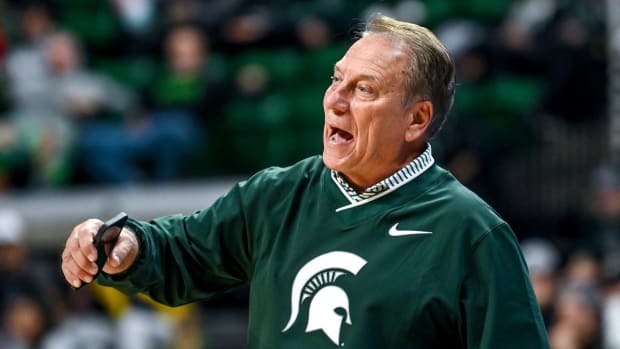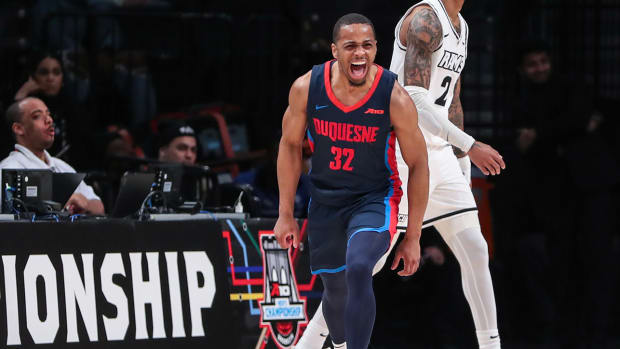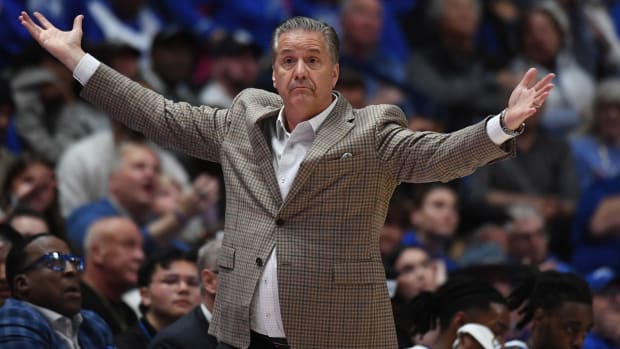USC, UCLA and the Big Ten: How and Why College Sports’ Latest Stunning Move Happened
Inside one of college football’s cathedrals last September, Oregon swarmed the Ohio Stadium field in a joyous postgame celebration after stunning the Buckeyes in a rousing early-season upset.
It was a signature win for then coach Mario Cristobal, a rare victory by the West in the East and a crowning moment for new Pac-12 commissioner George Kliavkoff. High above the field that day within the Ohio State press box, Kliavkoff and Big Ten commissioner Kevin Warren strode side by side through the hallways—seemingly fast friends, business partners and likeminded men whose collective interest was calming the college sports landscape after the SEC’s big splash.
In fact, in one of his first moves as the league’s leader, Kliavkoff had struck what seemed like a landmark deal on the heels of Texas’s and Oklahoma’s moves from the Big 12 to the SEC. He convinced the Big Ten and ACC to form an alliance where they collectively agreed not to poach each other’s members, a pact that featured no binding contract but was termed a “gentleman’s agreement.”

Pac-12 commissioner George Kliavkoff now faces immense pressure to keep his conference afloat.
Kelvin Kuo/USA TODAY Sports
Now, less than 10 months later, the Alliance is dead. The Big Ten is expanding. The Pac-12 is scrambling. And for a second straight summer, a pair of blueblood sports programs—this time, UCLA and USC—have delivered a seismic move that will have far-reaching impacts on the college sports landscape. In a vote Thursday evening, Big Ten presidents and chancellors accepted applications from the Trojans and Bruins to start play in the conference in 2024—stretching the league coast to coast, from New Jersey (Rutgers) to Los Angeles.
It was a stunning announcement, but an understandable move given the current state of college football TV contracts, where two leagues, the Big Ten and SEC, are seeing dramatic increases in media-rights dollars.
Sources tell Sports Illustrated several schools across the country are jockeying to land in one of the two conferences, a multiteam shift that many believe will result in the two conferences—35 to 40 teams—separating themselves from the rest of the pack.
“This has now happened twice,” one Power 5 athletic director says, referencing the Longhorns’ and Sooners’ moves to the SEC, expected to happen at latest in 2025. “Once is an accident. Twice is a trend. Are we on the precipice of another major change?”
“This is a sea change,” says an administrator in the Big 12. “This is two founding members of the league that’s won the most national championships in the nation.”
The news crashed through college sports like a tidal wave, shocking administrators and fans.
For the Big Ten, it was an easy decision. Much like Texas and Oklahoma, USC and UCLA approached the Big Ten with a message: They were planning to leave the Pac-12 and wanted to know whether the league was interested in accepting them.
“You have to be a moron to not think about it,” a Big Ten source says. “They would have gone somewhere else if we said no.”
High-level sources say that conversations between the league and schools intensified over the past few weeks and may have been the impetus behind an unexpected delay of the Big Ten’s new media-rights announcement, surely held up by the potential of two additions that reside in the rich Los Angeles market. During a conversation in early May, Warren said that the conference’s new TV deal would be announced around Memorial Day. In early June, a Big Ten source said the deal was being delayed until July or potentially August.
With UCLA and USC on board, the Big Ten’s media-rights deal, already projected at $1 billion a year, is expected to increase to a number that would roughly triple what Pac-12 and ACC schools each receive in distribution each year. Apple reengaged with the league after Thursday’s news, according to Sports Business Journal.
The move came together somewhat swiftly and was kept under wraps, as Warren worked in the shadows to hide the bombshell he was cooking up. Word first leaked Thursday afternoon from the San Jose Mercury News, hours after Big Ten presidents met Wednesday night in an informal vote to advance the process to Thursday’s official adoption. Many in the Pac-12 were caught off guard, similarly to those in the Big 12 last July. The Pac-12 statement expressed “surprise and disappointment.” Sources said there was a Pac-12 athletic directors meeting Wednesday, and neither UCLA nor USC tipped its hand. One Pac-12 administrator says they couldn’t believe the University of California state system would allow the Bruins to bolt and leave its brethren in Berkeley behind.
The Big Ten was serious enough about expansion that Warren created a group that one person described as “an expansion subcommittee” of conference administrators to explore adding teams. “Something was going to happen to combat the Texas and Oklahoma move,” one Big Ten source says.
Now, the remaining Pac-12 teams are seemingly free agents. Conference media-rights deals normally lock in league members until they expire. The Pac-12’s TV deal ends in 2024. If UCLA and USC didn’t leave now, they were risking being in the conference under a new, potentially long-term contract. A Power 5 athletic director sums it up best: “If you don’t get out now, you’re stuck like Clemson and UNC in the ACC.”
The ACC’s media-rights deal stretches to 2036, a ghastly long contract that has put league members in a precarious position. The teams’ annual distribution, roughly $35 million annually to each school, is a fraction of what Big Ten and SEC teams stand to get. It could make for more jockeying from some of the ACC’s most attractive teams, such as Clemson, North Carolina, Miami and Florida State. Are they able to shake free of their binding, long-term deal with the ACC to join another league? Or will the ACC attempt to expand? It’s the only way to renegotiate the TV contract. The league has been public about its interest in adding Notre Dame on a full-time basis.
“How do we make this league survive, if it is survivable?” asks one ACC administrator.
And what of the Pac-12 now? It lost two of its biggest brands in its largest metro market. Last year, reeling from the departure of Oklahoma and Texas, the Big 12 approached the Pac-12 about a merger. Will the opposite happen now? The shoe, as they say, is on the other foot. Or will the Big 12 attempt to raid what’s left of the Pac-12?
“Do you destroy another league or merge?” an official asks.
And maybe the Big Ten isn’t finished expanding. Could a 16-team league be 18 or 20? A half dozen colleges—most of them from the Pac-12—have reached out to the conference with an interest in joining, a source says. Big Ten officials will review and study options, but nothing is expected soon or is imminent.
So, fewer than 10 months after Oregon took down Ohio State, after the West beat the East, after two commissioners walked side by side in line, college sports continues to fracture from within.
And what of the Alliance?
“Well,” says a Big Ten source, “it probably ceases to exist.”
Information from SI senior writer Pat Forde was used in this story.
Keep up with college football all year long with fuboTV: Start a 7-day trial today!
More Conference Realignment Reaction:




